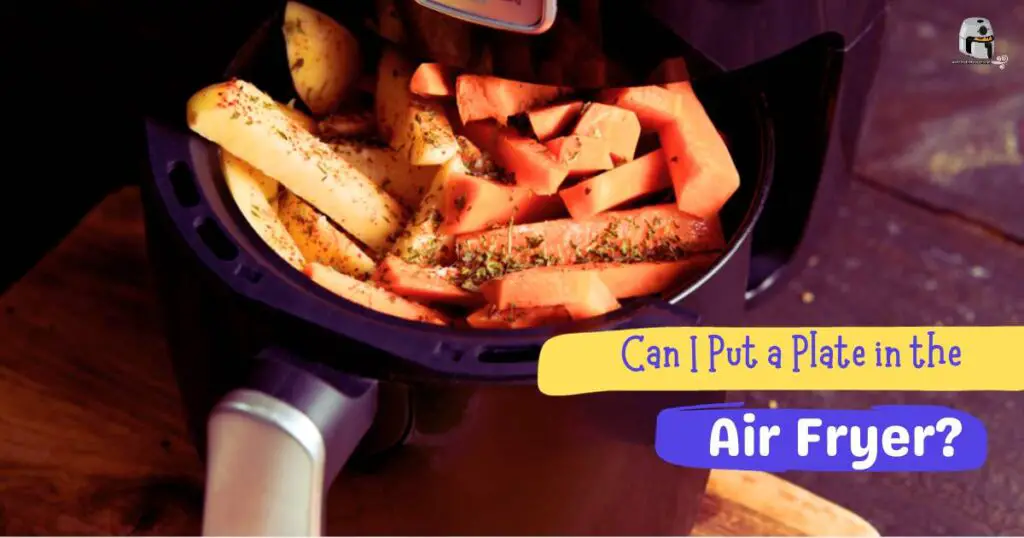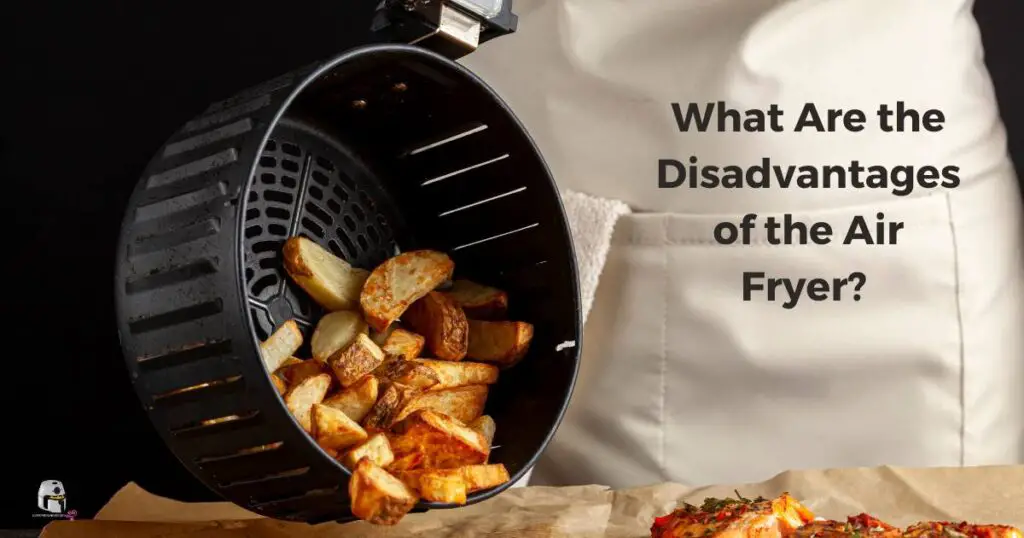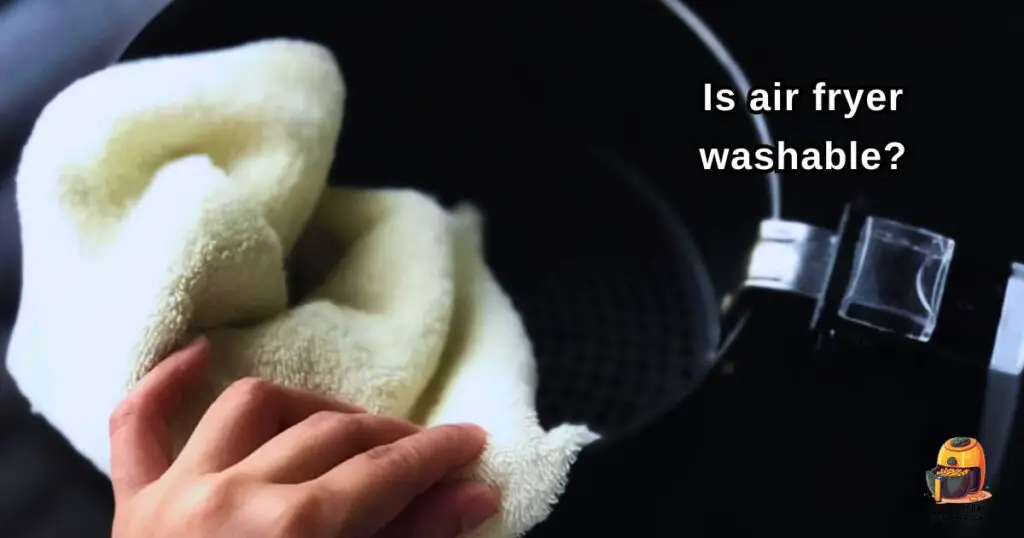Table Of Contents
- How Does an Air Fryer Cook Food if You Use a Plate?
- Problem With Placing a Plate in an Air Fryer
- 7 Types of Plates That Are Safe to Use in an Air Fryer
- Types of Plates to Avoid Using in an Air Fryer
- What to Consider Before Using the Plate in an Air Fryer?
- Tips for Using Plates in an Air Fryer
- FAQs
- Final Verdict
Yes, you can put a plate in the air fryer, but it should be oven-safe and able to withstand the air fryer’s temperature. Avoid using plates made of glass or delicate materials that may shatter or warp under high heat.
It’s essential to leave some space between the plate and the air fryer’s heating element to allow for proper air circulation. This can help ensure even cooking.
Using a plate can be convenient for reheating or cooking certain dishes, but always check the plate’s safety guidelines and the air fryer’s manual for compatibility and recommendations.

How Does an Air Fryer Cook Food if You Use a Plate?
When you place a plate inside the air fryer along with the food, a few things happen. Let’s look at the details below:
Uniform Heat Distribution
When a plate is employed in an air fryer, it plays a crucial role in promoting consistent cooking. Hot air circulates evenly around the food, preventing certain areas from getting overcooked or undercooked. This uniform heat distribution ensures that your dishes turn out perfectly cooked, with consistent textures and flavors throughout.
Reduced Cooking Times
Using a plate inside the air fryer can lead to significantly shorter cooking times. This is due to the plate’s ability to absorb and retain heat, effectively acting as an additional heat source. Consequently, your meals can be prepared faster and more efficiently, making the air fryer an even more time-saving kitchen appliance.
Moisture Retention
To prevent food from drying excessively during air frying, you can place a sheet of parchment paper or aluminum foil on top of the plate. This layer helps trap moisture, preserving the juiciness and tenderness of your dishes. It’s particularly beneficial for items like chicken, fish, or vegetables you want to keep succulent.
Enhanced Versatility
Using a plate expands the range of dishes you can prepare in the air fryer. It’s especially useful for cooking foods that might be challenging to handle directly on the air fryer basket, such as delicate items like flaky fish fillets or small, loose ingredients like diced vegetables.
Ease of Cleanup
Cooking on a plate in the air fryer can simplify cleanup. Any drips or residue are more likely to be contained on the plate, reducing the need for extensive cleaning of the air fryer basket.
In summary, incorporating a plate into your air fryer cooking routine offers several advantages, including even heat distribution, faster cooking times, moisture retention, increased versatility, and simplified cleanup. These benefits can result in improved cooking outcomes and greater convenience when using your air fryer for various dishes.
Problem With Placing a Plate in an Air Fryer
While using a plate in an air fryer can offer advantages, there are some potential issues and considerations to keep in mind:
Size and Fit Issues
The size and shape of the plate must match the air fryer’s dimensions. If the plate is too large, it can obstruct the airflow, reducing the effectiveness of the air frying process. Conversely, if it’s too small, it might not accommodate the amount of food you want to cook.
Cooking Time Adjustments
Elevating food on a plate can change its proximity to the heating element. This can lead to variations in cooking times, making it necessary to adjust your recipes to ensure that the food cooks evenly and thoroughly.
Plate Material Safety
The material of the plate is critical. While metal plates are generally safe and can assist in even heating, plates made of glass or certain ceramics may shatter due to rapid temperature fluctuations within the air fryer. This poses safety risks and could damage the appliance.
Loss of Direct Contact
Placing food on a plate can reduce its direct contact with the air fryer basket. While this can prevent sticking, it may affect the texture of certain foods, especially if you’re aiming for a crispy crust or browning effect.
Plate Maintenance
After use, the plate requires cleaning, adding an extra step to your post-cooking cleanup routine. Depending on the plate material, it may require special care or cleaning instructions.
Space Limitations
Using a plate reduces the available cooking space in the air fryer. This can be a drawback if you need to prepare a large quantity of food in a single batch or if you’re cooking multiple dishes simultaneously.
Airflow Concerns
Even with a well-fitted plate, it’s essential to ensure that there’s adequate airflow around the plate to allow the hot air to circulate properly. Proper airflow is critical for achieving optimal cooking results.
7 Types of Plates That Are Safe to Use in an Air Fryer
When considering plates to use in an air fryer, it’s crucial to choose materials that can withstand the high temperatures and rapid temperature changes inside the appliance. Here are the types of plates that are generally safe to use in an air fryer:
1. Heat Resistant Materials
When choosing plates for your air fryer, prioritize materials that are heat resistant. It’s crucial to use plates that can withstand high temperatures, typically up to 400°F (200°C) or higher, to avoid any safety hazards. Heat-resistant plates not only ensure the integrity of the plate but also contribute to more even cooking results.
2. Ceramic Plates
Ceramic plates are a viable option for air fryer cooking if they are labeled as oven-safe and capable of withstanding high temperatures. Ceramic is known for its even heat distribution, making it an excellent choice for air frying. It promotes consistent cooking, resulting in well-cooked and flavorful dishes.
3. Porcelain Plates
Porcelain plates, a type of ceramic, are suitable for food preparation and can be used in the air fryer if they are oven-safe and heat-resistant. The non-toxic nature of porcelain makes it a safe choice for cooking. Check for an “oven-safe” label on the plate’s underside to verify that your porcelain plate is safe for air frying.
4. Stoneware Plates
Stoneware is a clay-based material known for its heat resistance, often capable of withstanding temperatures of up to 600°F (315°C). It provides consistent and even cooking temperatures, resulting in well-cooked dishes. Before using stoneware in an air fryer, consult the manufacturer’s instructions to confirm its heat resistance, typically up to 400°F (200°C).
5. Silicone Plates and Molds
Silicone molds are another option for air frying, but it’s essential to ensure they are heat-resistant up to at least 400°F before use. Preheating the silicone mold in the air fryer for a few minutes before cooking can help ensure it fits securely and allows hot air to circulate freely. Specialized silicone molds designed for air fryers are readily available and are made to withstand high temperatures, making air frying a convenient option for baking and cooking.
6. Metal Plates
Oven-safe materials such as copper, alloy, aluminum, stainless steel, and cast iron plates can also be safely used in an air fryer as long as they are capable of resisting temperatures up to 400°F. Metal plates efficiently conduct heat, helping achieve even cooking results.
7. Glass Plates
Glass plates labeled as heat-resistant and oven-safe can be used in an air fryer, but not all glass plates meet these criteria. Before using glass, ensure it’s labeled as oven-safe and heat-resistant. Adjust the cooking temperature down by 25°F and increase cooking time. Ensure the glass is at room temperature, check for cracks, and never exceed 450°F.
Types of Plates to Avoid Using in an Air Fryer
Selecting the right plates for your air fryer ensures safe and effective cooking. Here’s an in-depth guide to plate types that should be avoided:
1. Plastic Plates
Steer clear of plastic plates, even if they are labeled as microwave-safe. Plastic cannot withstand the high heat produced by air fryers. Using plastic plates in the air fryer can lead to melting, potentially damaging your appliance. Moreover, melted plastic can release harmful petroleum-based chemicals, posing health risks if absorbed by your food.
2. Paper Plates
Paper plates are unsuitable for air frying due to the extremely high temperatures the air fryer can reach. They are inherently flimsy, and exposure to heat further weakens their structure. Moreover, paper plates tend to absorb moisture and liquid, causing your food to become dry. Using paper plates in the air fryer is a fire hazard and can potentially lead to damage to both your appliance and your home.
3. Cardboard Plates
Similar to paper plates, cardboard plates are unsuitable for use in your air fryer. They lack the ability to withstand high temperatures and are prone to absorbing moisture from the food. Beyond that, cardboard plates pose a significant fire hazard, making them unsafe for air frying.
4. Non-Heat Resistant Glass Plates
Most glass plates are not designed to be heat-resistant and should be avoided in the air fryer. If a glass plate is not explicitly labeled as heat-resistant, refrain from using it. Opt for heat-resistant and oven-safe glass plates that are explicitly designed for high-temperature cooking. Refer to the previous section for safe practices when using heat-resistant glass plates in your air fryer.
What to Consider Before Using the Plate in an Air Fryer?
Before using a plate in an air fryer, there are several essential considerations to ensure safe and effective cooking:
- Select an appropriate plate material for your air fryer. Common choices include metal, ceramic, heat-resistant glass, silicone, and specific stoneware. Each material has unique properties that can affect cooking results, so choose based on your specific needs.
- Confirm that the plate can withstand the high temperatures produced by the air fryer, which can often reach 400°F (200°C) or more. Using plates not designed for high-heat cooking can lead to warping, melting, or safety hazards.
- Ensure the plate’s dimensions allow it to fit comfortably within the air fryer basket. Proper sizing is essential to maintain proper airflow, ensuring even cooking throughout the food.
- Consult the user manual or guidelines provided by the air fryer manufacturer. Some models have specific recommendations regarding the types of plates and accessories that are safe to use with their appliances.
- Thoroughly inspect the plate for any signs of damage, such as cracks, chips, or wear. Using a damaged plate can lead to further breakage or safety issues during cooking.
- Consider the type of food you plan to prepare. Different plates are better suited for various dishes. For instance, a metal rack or grill plate may work well for items benefiting from elevated cooking, while a ceramic plate may be suitable for reheating or baking.
- Be prepared to adjust cooking temperature and time based on the plate material and the distance between the plate and the heating element. Elevating the food on a plate can affect cooking dynamics, requiring modifications for optimal results.
- Depending on the plate material, preheating the plate in the air fryer for a few minutes before adding food can be beneficial. Preheating ensures that the plate reaches the desired temperature for cooking, promoting consistent results.
- Securely position the plate within the air fryer basket, ensuring it sits level and stable. This prevents any shifting or tipping during the cooking process, promoting even cooking and safety.
- Consider the ease of cleaning the plate after use. Some materials, such as silicone and those with non-stick coatings, are more convenient to clean than others, reducing post-cooking cleanup efforts.
- Always follow general safety precautions when using your air fryer. This includes keeping the appliance on a stable surface, avoiding overcrowding the basket to allow proper airflow, and keeping flammable materials away from the air fryer during operation.
Tips for Using Plates in an Air Fryer
Using plates in an air fryer can enhance your cooking versatility, but following specific guidelines is crucial for safe and effective results. Here are valuable tips to consider:
- Always verify the plate’s material before placing it in the air fryer. Suitable materials include metal, ceramic, heat-resistant glass, silicone, and some stoneware.
- Ensure that the plate’s size allows it to comfortably fit within the air fryer basket. Leave some room around the edges to facilitate even airflow, promoting consistent cooking.
- Examine the bottom of the plate to verify its safety. Look for labels indicating that it’s oven-safe. The presence of a flame symbol inside a circle is also a reassuring indicator.
- Never use microwave-safe plastic plates in the air fryer. They are not designed to withstand the high temperatures of air frying and can melt or release harmful substances.
- Preheat the air fryer before adding both the food and the plate. Preheating ensures that the plate and the food start cooking immediately, promoting even cooking results.
- Never place cold plates directly into a hot air fryer. Allow the plate to reach room temperature or preheat it along with the air fryer to prevent thermal shock.
- Ensure that the food on the plate is not touching or overlapping. Proper spacing allows hot air to circulate each item, resulting in even cooking.
- Cook the food according to the recipe directions, but keep an eye on it to ensure even cooking. Adjust cooking times or temperatures if needed.
- When the cooking cycle is complete, use oven mitts or heat-resistant gloves to safely remove the hot plate from the air fryer basket. The plate will be extremely hot and can cause burns if handled directly.
FAQs
Is It Safe to Use a Plate in an Air Fryer?
Yes, it is safe to use a plate in an air fryer if the plate is made of a heat-resistant material, fits comfortably in the air fryer basket, and is labeled as oven-safe. Proper precautions must be taken to ensure safe and effective cooking.
Can I Put Metal Plates in Air Fryers?
Yes, you can put metal plates in air fryers as long as they are made from materials. That can withstand the air fryer’s cooking temperatures, typically up to 400°F (200°C) or higher. It’s essential to use oven-safe metal plates for safe and effective cooking.
Final Verdict
Certainly! Using a plate in your air fryer can be both safe and transformative for your cooking. Just make sure the plate is constructed from heat-resistant, oven-safe materials and fits comfortably within the air fryer’s basket. Remember to preheat the air fryer and plate for optimal results, but never place a cold plate into a hot fryer.
By following these simple yet essential steps, you can unlock a world of culinary possibilities and savor perfectly cooked dishes. Always consult your air fryer’s manual for specific instructions. Happy cooking!
You May Also Like to Read:







